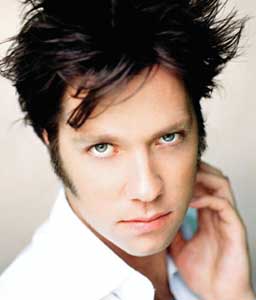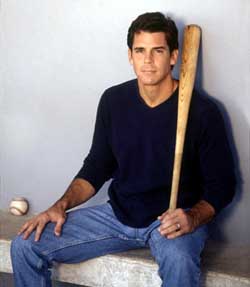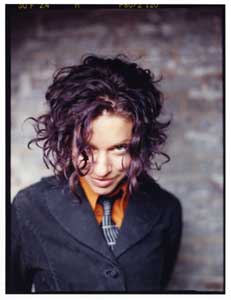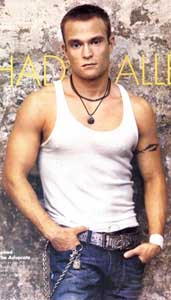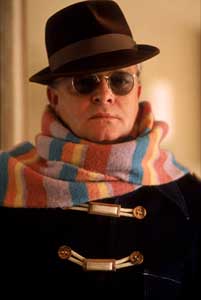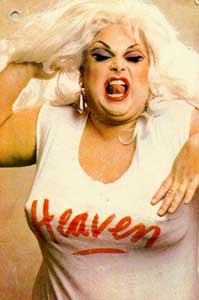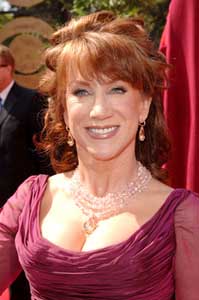-
- GLBT community speaks out against hate crimes
- Suspects plead not guilty in Pride hate crime attacks
- Audit Committee report finds council, pension board acted improperly and illegally
- ‘Clear the Air’ ads hit local cable stations
- Researchers: Meth promotes HIV infection at the cellular level
- Community News
-
- In the home of Amendment 2, a complicated fight over same-sex marriage
- As defeats pile up, Massachusetts stays sole safe haven for same-sex marriage
- Iowa high court upholds man’s criminal HIV-spreading convictions
- Aging face of HIV poses new medical challenges
- Explanation of same-sex marriage referendum leads to war of words
- San Francisco Catholic Charities dodges gay adoptions
- National News Briefs
- World News Briefs
feature
Beyond Cher
A look at our icons and dycons
Published Thursday, 10-Aug-2006 in issue 972
Any time a list is compiled, a book written or a discussion raised about gay icons, there is sure to be a great deal of debate. Icons, or those perceived to be such, are purely subjective.
The word “icon” has its roots in the Greek word “eikon,” meaning “image, figure, representation.” Over time, the term has evolved. It was used extensively by the Eastern Church to be a “representation or picture of a sacred or sanctified Christian personage.” As the medium of television and radio appeared, the term took on a new twist of the old meaning and came to mean “one who is the object of great attention and devotion; an idol.”
For our purposes this week, we will use the term “icon” to represent someone who has a strong connection with a community or culture. By definition, an icon is a larger-than-life celebrity or historical figure who is perceived to have conquered some area of life, and, in the process, has become endeared by a group of individuals.
Judy. Ellen. Rosie. Madonna. These are, of course, the names that many in the GLBT community say come to mind first when talking about gay icons.
“I think there is something very tragic about Judy Garland that makes her an enduring icon in our community,” says Gary Pointer, 28, of downtown. “But I think what’s interesting about her is that she isn’t remembered for her amazing role in Meet Me in St. Louis, singing ‘The Trolley Song,’ but rather for her role in The Wizard of Oz.”
And, in particular, argues Pointer, for her performance of “Somewhere Over the Rainbow.”
“I think that’s the connection most gay people make: Judy and the rainbow,” Pointer says. “So, really, you may have an icon – Judy – whose voice endures as the quintessential representation of the gay icon, the rainbow flag.”
“I think it’s hard to imagine somebody being able to reinvent themselves so many times with a name like Suzie. There is something really satisfying about being able to connect the word ‘Madonna’ with so many sexy, sultry or counterculture identities.”
However, says Mark Lawson, 63, of Mission Hills, that logic misses one small detail: The rainbow flag didn’t appear until the late 1970s, while the film appeared in 1939.
“Judy was an icon from the moment she stepped onto the big screen,” Lawson says. “She was so vulnerable and beautiful. And she always took us to worlds with lollipops and gumdrops and color and light. But we all knew the personal hell she was going through. Her roles on the big screen were in direct contrast to her everyday life, just like ours were.”
For both Pointer and Lawson, Garland embodies one of the main criteria for being an icon: endurance through time. She speaks to both of these men regardless of their generation.
Where Garland was vulnerable and has endured as an icon for the GLBT community, few would describe Madonna as vulnerable.
Instead, says Tony Sanchez, 42, of South Park, Madonna – the singer, that is – is all about what he calls “iconic incarnations.”
“There is no one Madonna,” Sanchez says. “From ‘Material Girl’ to ‘Vogue’ to mommy to Kabbalah, and now to her charity work, she is the ‘it’ girl for most gay men I know.”
She also, Pointer argues, fits the same duality as Garland. She has a dual iconic connection: Her name represents one of the most common icons of the Christian world.
“I think it’s hard to imagine somebody being able to reinvent themselves so many times with a name like Suzie,” Pointer says. “There is something really satisfying about being able to connect the word ‘Madonna’ with so many sexy, sultry or counterculture identities.”
It’s not nearly as philosophical for Sanchez.
“Look, Madonna didn’t keep up with the times, she made the times,” Sanchez says. “And she did it with such a sexy connection, with such a fierce determination, that we all have had to buy in. She didn’t really go through any personal hell. Isn’t that what that whole book and movie [Sex] really showed? What she did was just be tough as nails and bitch her way through life. And she comes out on top every time. What gay man doesn’t want to do that?”
For every fierce moment from Madonna, one her best friends, Rosie O’Donnell, was having a hundred “nice” moments.
O’Donnell, who hosted her own talk show, the widely successful “The Rosie O’Donnell Show” (1996-2002), was early on dubbed “The Queen of Nice” for her charity work, her easygoing style on her show and her love for all things musical. Even before O’Donnell came out publicly, she was an icon in the GLBT community. She was single, rumored to be a lesbian, an adoptive mother and had an obsession with Tom Cruise.
“OK, so here is this woman, right, who loved musical theater and Tom Cruise,” says Andrew Mullins, 46, of North Park. “I mean, what gay man didn’t? And she was always nod-nod, wink-wink about gay issues.”
“Man, we marched in streets celebrating. I mean, most psychiatrists still thought homosexuality was a mental disorder. I was in college and to have someone elected that reflected me, now that was amazing. I was studying to be a teacher, so he was really a figure in my life. [Harvey Milk] helped defeat Prop. 6, which would have made it legal for teachers to be fired for being gay. He had such charisma.”
And for many it didn’t seem to matter if O’Donnell was closeted.
“It was different,” Mullins argues. “Most of us know what it is like to be closeted, to know that your career and reputation depend on gender-neutral discussions, avoiding direct dialogue, all of that. And that was cool. But what was really cool was when she did come out. By the time Rosie finished her show, she had built a talk-show reputation as solid as Johnny Carson, as far as most people were concerned. And here she was saying, ‘I’m a lesbian and a mom, and I have it all.’”
And that, says Sarah Hamilton, 38, of North Park, is precisely what drew her and her friends to O’Donnell even before the 2002 announcement.
“I don’t know how many times we went to her show,” Hamilton says. “It was so great. She had a way of making everyone in the recording room feel like they were the guest of honor.”
But when O’Donnell came out and began her efforts to recognize the power of gays and lesbians in raising families, she quickly fell off the guest list for many people.
For Samantha Brant, 30, of Escondido, that brings to mind another icon, Ellen DeGeneres. After all, says Brant, “Ellen was out way before Rosie.”
“And not the Ellen that has her own talk show now, even though she’s cool on that,” Brant says. “But the Ellen who says, [‘Yep,] I’m Gay’ on the cover of frickin’ Time magazine [April 14, 1997]. I was just coming out of a relationship with a guy in college, and I was so depressed. I couldn’t figure out why. And then all this stuff comes down about Ellen.”
Brant is referring to DeGeneres’ popular TV sitcom, “Ellen,” which aired from 1994 to1998 and was a ratings bonanza well beyond the GLBT community. On that fateful night in living rooms across America, DeGeneres’ alter ego, Ellen Morgan, kissed Laura Dern.
It would bring down the wrath of the evangelical right, led by the Southern Baptist convention and Jerry Falwell, among others. Their boycott of Disney (the parent company for ABC television) would last for more than eight years. DeGeneres’ show would be canceled the next season.
For O’Donnell, who came out five years after DeGeneres, a similar series of events would occur. Her show ended. She became embroiled in a nasty court battle over magazine publishing. Former supporters trashed her newly chosen hairstyle as “too manly” or “too butch.” Her Broadway debut as a producer of Boy George’s Taboo failed miserably.
The experiences of DeGeneres and O’Donnell’s post comings-out would be enough to silence just about anyone. But not DeGeneres and O’Donnell. In fact, they are both back, stronger than ever. DeGeneres has her own talk show, and O’Donnell has been invited to join “The View” with Barbara Walters.
“It was so amazing. And we just knew Rosie was a survivor,” Hamilton says. “And now, with her work on the lesbian family cruises and her work on Broadway with Boy George, she’s putting herself out there again and again, and it’s for us.”
And that includes, says Jill Watson, 23, of La Mesa, when O’Donnell and her partner, Kelli, were married in San Francisco in 2004.
“She’s a trailblazer for us to look up to,” Watson says. “She’s not had it easy since she came out, but she keeps fighting. A lot of people attacked her when she came out, but by then I think she was strong and she was ready. And I’ve never heard of Rosie backing down. She’s one tough dyke.”
“It’s unlikely either Matthew Shepard or Mark Bingham ever desired icon status. But the fact that their deaths were so tragic, and became the source for new endeavors and triumphs, puts them in that category.”
For Jane Pena, 53, of Carlsbad, the same is true for DeGeneres.
“Ellen took some huge hits when she came out,” says Pena. “Her whole life crumbled around her. One week, everyone is having a big party, and the next week, we were like, ‘Oh, crap, this is not good.’ But look at her. She’s hosting her own talk show. She’s hosting some of the biggest award shows. And she is as funny, beautiful and as inspiring as ever. She met that crap head-on and she came out a winner. And that means we all came out winners.”
Hence the term “dycon.” The Urban Dictionary defines a dycon as “a lesbian role model or someone who is your icon who is a lesbian.” For Pena, Watson, Hamilton, Brant and Mullins, that’s a great word.
For DeGeneres and O’Donnell, part of their iconicity is that by coming out, they manage to subvert the straight world’s view of homosexuality. In O’Donnell’s case, she was a loving partner, a mother and a household name due to her hugely successful talk show. For DeGeneres, she was a successful TV star, had a gorgeous movie-star girlfriend, Anne Heche, and had been photographed with the president with said girlfriend.
And while both took an initial hit, they both are true survivors and role models.
While some icons, like Judy Garland, have endured through time, there are some emerging icons within the GLBT community. Think of it as a then vs. now iconography.
Carol Caplan, 34, of North Park, is a graduate student in queer studies. For Caplan, there are a lot fewer than six degrees of separation in the gay iconography of then vs. now.
“Many of the people we think of as icons in today’s news have a very close connection to those classical GLBT icons,” argues Caplan.
Take Rufus Wainwright, for example. An out singer and songwriter, Wainwright has a strong following within the GLBT community and is considered an emerging icon of song. In 1998, Wainwright was named Best New Artist by Rolling Stone. He toured with fellow gay icon Tori Amos. Having recorded “I’m Your Man” for the movie Brokeback Mountain, Wainwright is no stranger to referencing homosexuality in his music. On June 14, Wainwright gave a concert at Carnegie Hall and recorded an entire album at the very same location Judy Garland recorded at 35 years ago.
And, of course, says Caplan, “there is Liza with a ‘Z,’ Garland’s daughter,” referring to Liza Minnelli.
“It’s hard to imagine that Liza would be Liza without Judy,” avers Caplan. “However, keep in mind that Liza’s dad was also the powerful second husband of Judy, Vincente Minnelli.”
Vincente Minnelli produced Meet Me in St. Louis, starring Garland, which was in large part what launched the young actress’ career. Liza Minnelli appeared in her first film, In the Good Old Summertime, with her mother in 1949. Other connections to gay icons include Minnelli having lost out to Chita Rivera for a Tony in 1984 (though Minnelli is one of the few “Triple Crown” winners, having an Oscar, a Tony and an Emmy – not to mention a Golden Globe and a Grammy).
Virginia Woolf is considered one of the greatest dycons in classic GLBT iconography. Author of Mrs. Dalloway and To the Lighthouse, Woolf was not only one of the great feminists of her time, but is still considered today to be one of the premier authors to have explored sexuality in general and lesbian issues specifically. Part of Woolf’s enduring iconicity were her bouts with depression. At the age of 59, having filled her pockets with stones, Woolf drowned herself in the River Ouse, near her home in Rodmell, England.
Today, the Indigo Girls are one of the most popular and successful folk/pop duos in recording history. Both Amy Ray and Emily Saliers are out lesbians and are considered, along with Melissa Etheridge and k.d. lang, to be among the top lesbian singers.
In their 1995 album, 1200 Curfews, the Indigo Girls wrote the song “Virginia Woolf.” Part of their lyrics are: “The place where you hold me / Dark in a pocket of truth / The moon had swallowed the sun and the light of the earth / And so it was for you / When the river eclipsed your life / And set your soul like a message in a bottle to me / And it was my rebirth / So we know we’re all right.”
Rock Hudson and Elizabeth Taylor had onscreen chemistry that few would deny.
And, as with the examples of Madonna and good friend Rosie O’Donnell, there is a great deal of connection as well.
Timothy Montana, 67, of Bankers Hill, considers himself an expert on Marilyn Monroe.
“Marilyn Monroe was every straight man’s fantasy, from baseball legends to those in the upper decks, from the Oval Office to the front office,” says Montana. “But more than that, she was every gay man’s fantasy, too. Every gay man I know would have switched for Marilyn. And most, at some point or another, have struck a Marilyn pose or pouted a lyric or two.”
What makes Monroe an enduring icon in the GLBT community is not only her style – and not even that gay icons Andy Warhol and Elton John have immortalized her – but the tragedy of Monroe’s personal life. Like Woolf, Monroe committed suicide, unable to please the men in her life. (Ironically, Montana pulls from his factoid mind that both Leonard Woolf and Joe DiMaggio’s birthdays were Nov. 25.)
“How many of us haven’t thought about that at one time or another?” says Montana. “I mean, it’s not a stretch to see that here are two women, both vulnerable in their own way, who simply couldn’t handle the pressure of society.”
It speaks volumes, Montana says, that today’s icons like DeGeneres and O’Donnell have been able to persevere.
Onscreen chemistry has also propelled duos or ensembles into iconoclastic status – and some have unintended consequences.
Rock Hudson had co-stars that read like a who’s who list of 1950s and 1960s glamour-girl gay icons: Elizabeth Taylor (who later won awards portraying Woolf’s scary protagonist Martha on screen), Doris Day, Jane Wyman and Lauren Bacall. Hudson’s career came to a tragic end when, in 1984, he signed on for a role in television’s “Dynasty” but had memory trouble. In 1985, Hudson helped former co-star and friend Doris Day launch her cable show “Doris Day’s Best Friends.”
In the end, it was a Variety magazine columnist who broke the news that Hudson had AIDS. It was a jolt to the mainstream public.
“Visibility demystifies,” says Steven Winters, 64, of South Park. “I will never forget the media that surrounded that revelation. And then when Hudson’s former partner [Marc Christian] sued for having been exposed to the virus, it was tragic for everyone dealing with this crisis.”
It was out of this tragedy that gay icon Elizabeth Taylor became an activist for AIDS charities.
Over time, onscreen chemistry and its impact on GLBT culture has changed. “Designing Women” (which had gay icon Delta Burke) and “Golden Girls” (which had dycon Bea Arthur and gay icon Betty White, who often traded barbs with Charles Nelson Reilly on the hugely popular game show “Match Game”) extended their chemistry beyond the mainstream media and deeply impacted gays and lesbians.
Then there was the British import “Absolutely Fabulous” and the American mega hit “Sex and the City,” neither of which, like its predecessors “Designing Women” and “Golden Girls,” was overtly gay in any way. However, the crossover appeal created characters that endure as current gay icons.
Onscreen-chemistry couples that have risen to iconoclastic status in the GLBT community include Jack and Karen from “Will & Grace,” played by Sean Hayes and Megan Mullally. Today, cable brings us ensemble casts such as “The L Word,” “Queer As Folk” and “Noah’s Arc.”
No list of celebrity gay icons, past or present, would be complete without also mentioning: Bette Midler, Elton John, Cyndi Lauper, George Michael, Margaret Cho, Sir Ian McKellen, Sandra Bernhard, Julie Andrews, Barbra Streisand, Dolly Parton, Kathy Griffin, Joan Crawford, Divine, Freddie Mercury, Bernadette Peters, RuPaul, Grace Jones, ABBA, the Pet Shop Boys and the Village People – oh, and Cher.
Many in the GLBT community think the concept of icons is too narrowly focused on celebrities. They argue that there are areas beyond the glitz-and-glamour world of movies and television where iconoclastic individuals can be found.
Stephanie Tollman, 37, of North Park, is one of those people.
“There are doctors, scientists, politicians, athletes and any number of other areas to find heroes and icons,” says Tollman. “I mean, would anyone care about Lance and Reichen if they weren’t celebrities of some sort?”
Tollman is referring to Lance Bass and Riechen Lehmkuhl’s recent disclosure of their romantic relationship. Bass, formerly of the quintessential boy band ’N Sync, was recently outed. Lehmkuhl was half of the winning openly gay then-partnership of “Amazing Race.”
There are, of course, the fashion icons Tom Ford and Domenico Dolce and Stefano Gabbana, but even they tend to have their Hollywood-heavy appeal.
Take politics, for example. Likely the most prominent historical icon in California gay politics is Harvey Milk. Named one of Time’s top 100 most influential people of the 20th century, Milk became the first openly gay elected official of a major city. He was elected in 1977 to serve as a county supervisor in San Francisco.
Jim Alberts, 52, of City Heights, remembers the day Milk was elected.
“Man, we marched in streets celebrating,” recalls Alberts. “I mean, most psychiatrists still thought homosexuality was a mental disorder. I was in college and to have someone elected that reflected me, now that was amazing. I was studying to be a teacher, so he was really a figure in my life. He helped defeat Prop. 6, which would have made it legal for teachers to be fired for being gay. He had such charisma.”
Tragically, Milk never got to serve his full term. On Nov. 27 of the following year – the same year the Supreme Court refused to overturn a death sentence of a man convicted solely of having consensual sex with another man – former Supervisor Dan White shot Milk and Mayor George Moscone dead at City Hall. White had resigned partially due to the passage of Milk’s gay rights bill.
“Our celebration came to a screeching halt,” Alberts says.
Which makes the recent actions by Mayor Gavin Newsom with respect to marriage equality all the more affirming, Alberts says.
“When I heard that Newsom was giving out marriage licenses at City Hall back in San Francisco, I thought to myself, ‘He’s today’s Harvey.’ I just pray to God that we live in a time when the horrible tragedy of Harvey Milk can be prevented.”
Other politicians who have gained icon status for their endeavors include Congressmember Barney Frank, the longest-serving openly gay Democrat in Congress; Congressmember Jim Kolbe, the only openly gay Republican in Congress; and Congressmember Tammy Baldwin, the first openly gay or lesbian elected member of Congress.
Some icons achieve their status through sudden tragedy. Matthew Shepard was one such individual. A student at the University of Wyoming, Shepard was attacked, robbed, severely beaten and left for dead, tied to a fence near Laramie, Wyo., in 1998. The tragedy prompted then-President Bill Clinton to add sexual orientation to the list of biases for which crimes can be prosecuted as hate crimes.
Shepard’s parents went on to create the Matthew Shepard Foundation, an organization that focuses on education and the prevention of hate-based crimes.
Mark Bingham is another such individual whose tragic end brought him icon status. Bingham was aboard United Flight 93 on Sept. 11, 2001. Bingham is believed to have been among those brave passengers who stormed the cockpit to prevent the hijackers of that aircraft from completing their mission. Bingham called his mother on a cell phone shortly before the plane went down and said, “Some of us here are going to try to do something.”
Bingham was an avid rugby player, having played for the University of California at Berkeley, and played on a gay rugby team in San Francisco. Survived by his partner of eight years, Paul Holm (who was presented with an American flag by Senators John McCain and Barbara Boxer shortly after 9/11), Bingham’s legacy lives on through the Bingham Cup, an annual international rugby competition.
“It’s unlikely either Matthew Shepard or Mark Bingham ever desired icon status,” says Tollman. “But the fact that their deaths were so tragic, and became the source for new endeavors and triumphs, puts them in that category.”
Gwen Araujo became an icon for the community, specifically the transgender community, following her brutal murder in October 2002. Araujo was beaten to death by three young men after they discovered she was transgender. Since then, her story has been made into a TV movie for Lifetime and remains a tragic example of the continued discrimination and hate inflicted upon the transgender community.
Ask anyone who Michael Jordan, Jackie Joyner-Kersee, Babe Ruth, Mia Hamm, Tiger Woods or Shaun White is and you’re likely to get the right answer. Icons abound in sports for young men and women pursuing their dreams. Almost every population in America has athletes with household names – with one notable exception.
“Where are all the gay athletes?” asks Kristina Chang, 24, of University Heights. “OK, so there is, of course, Martina [Navratilova] and Billie Jean King, but those are the only lesbian sports icons I can think of.”
However, Sandra Klein, 53, of Carlsbad, says she sees a growing positive trend.
“Take [Amelie] Mauresmo, the tennis player, and Sheryl Swoopes [MVP of the WNBA],” argues Klein. “These women are at the top of their game, and they are willing to come out. It’s the boys that need to catch up.”
Chang does agree on that point.
“The only male athletes that I can think of are Billy Bean and Greg Louganis,” says Chang. “And these two guys didn’t exactly come out on their own terms.”
Historically, GLBT athletes have not come out on their own terms. But there are some icons from the past that may pave the way for today.
Take Bob Paris and Rod Jackson, for example. In 1985, Rod Jackson, a model and bodybuilder, and Bob Paris, a pro bodybuilder and future Mr. Universe, met and fell in love. Though outed by a British bodybuilder magazine in 1988, the couple turned it to their advantage. Paris granted interviews to Ironman and other publications in the business, and the couple agreed to be the so-called “poster couple” for gay America, appearing on the cover of The Advocate and BodyPower. The couple even went on to combine their last names, becoming Bob and Rod Paris-Jackson.
The Paris-Jacksons began talking about the troubles gay teens have in coming to grips with their sexuality. They carried their stories to Oprah, Donahue and Joan Rivers. They even co-wrote a book called Straight from the Heart about their relationship.
While their relationship did not last, their efforts on behalf of gay teens certainly earned them icon status.
More recently, Australian Ian Roberts had a similar turn of events. Roberts (who appears in this summer’s blockbuster Superman), was considered the John Elway of Australian rugby when he voluntarily came out in 1995. Roberts was at the top of his game and was generally supported by his fellow rugby players, and, even more importantly, by the fans.
Roberts was a popular spokesperson in Australia for products like Puma and Telstra. These companies did not pull their sponsorships. On the contrary, Roberts’ popularity soared.
“It had to do with integrity,” says Josh Cassidy, 39, of University Heights, who was living in Australia when Roberts came out. “Ian’s success – his continued success with his player friends and fans – had everything to do with not being ashamed of who he was. He’s an icon, alright. I don’t care if you call him a gay icon, a sports icon, an Australian icon or an integrity icon. An icon is an icon.”
If, indeed, an icon is an icon is an icon, then one would think that any discussion of iconic figures would be a slam dunk. Not true. With few exceptions (the most notable of which was Cher), for every person who answered the question, “Who is your favorite gay icon/dycon?” there were as many answers.
“I think the point that people need to understand is that an icon is only what the person or culture makes of it,” Caplan explains. “The sheer essence of a gay or lesbian icon does not change over time so much as the names or faces do. It’s really more how a culture or community reaches out and makes that connection with an idea or vision.”
Who do you think is an icon or dycon, and why? Send your responses to editor@-uptownpub.com.
|
|
Copyright © 2003-2025 Uptown Publications


